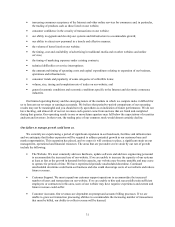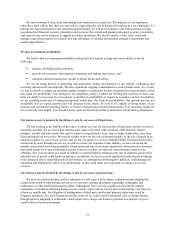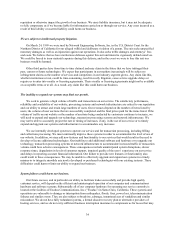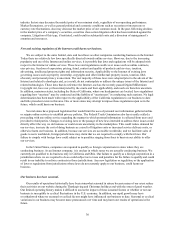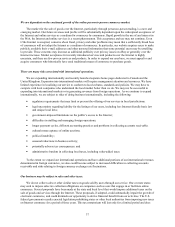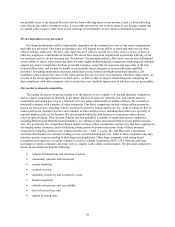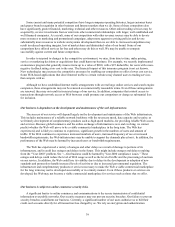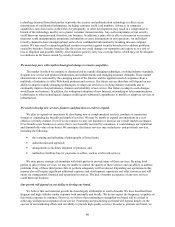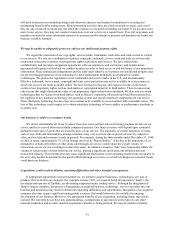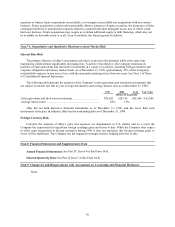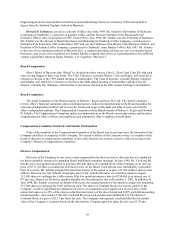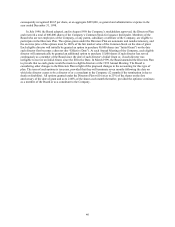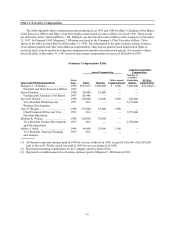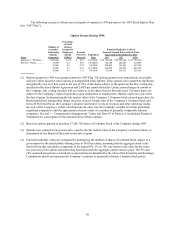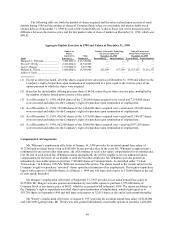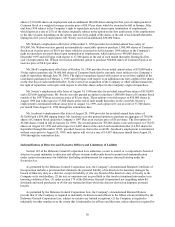eBay 1998 Annual Report Download - page 41
Download and view the complete annual report
Please find page 41 of the 1998 eBay annual report below. You can navigate through the pages in the report by either clicking on the pages listed below, or by using the keyword search tool below to find specific information within the annual report.41
will need to increase our marketing budget and otherwise increase our financial commitment to creating and
maintaining brand loyalty among users. Brand promotion activities may not yield increased revenues, and even if
they do, any increased revenues may not offset the expenses we incurred in building our brand. If we do attract new
users to our service, they may not conduct transactions over our service on a regular basis. If we fail to promote and
maintain our brand or incur substantial expenses in an unsuccessful attempt to promote and maintain our brand, our
business would be harmed.
We may be unable to adequately protect or enforce our intellectual property rights.
We regard the protection of our copyrights, service marks, trademarks, trade dress and trade secrets as critical
to our success. We rely on a combination of patent, copyright, trademark, service mark and trade secret laws and
contractual restrictions to protect our proprietary rights in products and services. We have entered into
confidentiality and invention assignment agreements with our employees and contractors, and nondisclosure
agreements with parties with which we conduct business in order to limit access to and disclosure of our proprietary
information. These contractual arrangements and the other steps taken by us to protect our intellectual property may
not prevent misappropriation of our technology or deter independent third-party development of similar
technologies. We pursue the registration of our trademarks and service marks in the U.S. and internationally.
Effective trademark, service mark, copyright and trade secret protection may not be available in every country in
which our services are made available online. We have licensed in the past, and expect to license in the future,
certain of our proprietary rights, such as trademarks or copyrighted material, to third parties. These licensees may
take actions that might diminish the value of our proprietary rights or harm our reputation. We also rely on certain
technologies that we license from third parties, such as Oracle Corporation, Microsoft and Sun Microsystems Inc.,
the suppliers of key database technology, the operating system and specific hardware components for our service.
These third-party technology licenses may not continue to be available to us on commercially reasonable terms. The
loss of this technology could require us to obtain substitute technology of lower quality or performance standards or
at greater cost.
Our business is subject to consumer trends.
We derive substantially all of our revenues from fees received from sellers for listing products for sale on our
service and fees received from successfully completed auctions. Our future revenues will depend upon continued
demand for the types of goods that are listed by users of our service. The popularity of certain categories of items,
such as toys, dolls and memorabilia, among consumers may vary over time due to perceived scarcity, subjective
value, and societal and consumer trends in general. For example, during the three months ended December 31, 1998,
we had, at times, approximately 7% of our listings involved in “Beanie Babies.” A decline in the popularity of, or
demand for, certain collectibles or other items sold through our service could reduce the overall volume of
transactions on our service, resulting in reduced revenues. In addition, consumer “fads” may temporarily inflate the
volume of certain types of items listed on our service, placing a significant strain upon our infrastructure and
transaction capacity. These trends also may cause significant fluctuations in our operating results from one quarter to
the next. Any decline in demand for the goods offered through our service as a result of changes in consumer trends
could harm our business.
Acquisitions could result in dilution, operating difficulties and other harmful consequences.
If appropriate opportunities present themselves, we intend to acquire businesses, technologies, services or
products that we believe are strategic. For example, in June 1998, we acquired Jump Incorporated (“Jump”), the
developer and operator of Up4Sale, an advertising-supported online trading service. Although the integration of
Jump is largely complete, the process of integrating an acquired business, technology, service or product into our
business and operations may result in unforeseen operating difficulties and expenditures. Integration of an acquired
company also may require significant management resources that would otherwise be available for ongoing
development of our business. Moreover, the anticipated benefits of any acquisition, including Jump, may not be
realized. We currently do not have any understandings, commitments or agreements with respect to any other
material acquisition and no other material acquisition currently is being pursued. We may be unable to identify,


